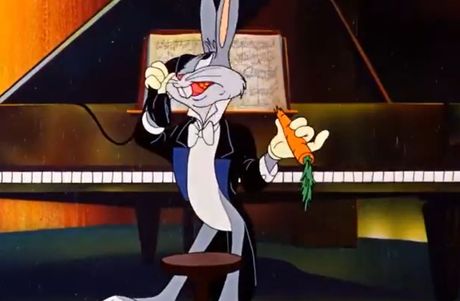Neverovatna povezanost klasične muzike i starih, legendarnih crtanih filmova

Tokom decenije mnoge generacije su odrastale uz nezaboravne crtane filmove, koji su definitivno ulepšavali detinjstvo svima nama. Da bi crtaći još bogatiji, u njih su ubačeni i neka vanvremenska klasična muzička dela.
A rezultat spoja je definitivno prava stvar.
To je uočio i korisnik Tvitera Vinsent Aleksander, koji nam je pokazao sve ovo u nekoliko primera.
- Mnogi od nas su naučili klasičnu muziku gledajući stare crtane filmove, pa ću identifikovati delove koji su se često pojavljivali.
Jedna od najprepoznatljivijih je "Mađarska rapsodija br. 2" Franca Lista, koju su izveli oni sjajni klavirski virtuozi Duško Dugouško i Tom i Džeri - naveo je u svojoj objavi Vinsent Aleksander.
Evo tog primera, kao i još mnogih takvih.
THREAD: Lots of us learned classical music from watching old cartoons, so I’m going to identify the pieces that frequently popped up.One of the most recognizable is Franz Liszt’s “Hungarian Rhapsody No. 2,” performed by those great piano virtuosos Bugs Bunny and Tom & Jerry. pic.twitter.com/SmyKbMpw3e— Vincent Alexander (@NonsenseIsland) March 1, 2021
An aria of Rossini’s “Barber of Seville” that shows up constantly in animation is “Largo al Factotum,” which introduces the Figaro character. Even the piece’s Wikipedia article credits the tune’s lasting legacy to its use in cartoons. Here are just a few iconic examples: pic.twitter.com/wtUms0adc3— Vincent Alexander (@NonsenseIsland) March 1, 2021
“Dance of the Comedians” by Czech composer Bedřich Smetana (from the comic opera THE BARTERED BRIDE) was used as an unofficial musical theme for the Road Runner cartoons. The propulsive energy of the piece matches well with Wile E. Coyote’s various failures. pic.twitter.com/5iHF49P2El— Vincent Alexander (@NonsenseIsland) March 1, 2021
“The Light Cavalry Overture” by Austrian composer Franz von Suppé was most memorably used in the Mickey Mouse short SYMPHONY HOUR, probably Disney’s funniest cartoon ever, where Goofy breaks all the instruments and the orchestra has to play a wacky Spike Jones-esque rendition. pic.twitter.com/Wr73FMzVYT— Vincent Alexander (@NonsenseIsland) March 1, 2021
Bugs Bunny famously conducted Franz von Suppé’s “Morning, Noon and Night in Vienna” in the classic BATON BUNNY. This cartoon has been screened with live orchestral accompaniment on Broadway, at the Hollywood Bowl, and the Royal Festival Hall for the royal family. pic.twitter.com/8BAe7JgO8b— Vincent Alexander (@NonsenseIsland) March 1, 2021
A CORNY CONCERTO, Bob Clampett’s hilarious spoof of Disney’s FANTASIA, brilliantly sets a violent Bugs Bunny chase to Johann Strauss’s peaceful “Tales from the Vienna Woods.” You can make any classical piece better by adding the “b-b-b-b-b” noise. pic.twitter.com/QxHovunpUM— Vincent Alexander (@NonsenseIsland) March 1, 2021
“Die Fledermaus” by Johann Strauss served as the entire basis for the 1950 MGM short TOM AND JERRY IN THE HOLLYWOOD BOWL. As with several Bugs Bunny shorts, this film later was actually screened at the Hollywood Bowl, with live orchestrations to go with it. pic.twitter.com/gJYRQznPR4— Vincent Alexander (@NonsenseIsland) March 1, 2021
Some pieces are ONLY famous due to their use in cartoons. I could find almost no information on Arthur A. Penn’s 1907 piece “Carissima,” but cartoon fans will remember its inclusion in this hilarious bit from the Sylvester cartoon BACK ALLEY OPROAR. pic.twitter.com/8RUXwkDNPk— Vincent Alexander (@NonsenseIsland) March 1, 2021
It's strange to be intimately familiar with a piece of music without ever actually knowing what it is. This piece is called "Sextet from Lucia di Lammermoor" by Gaetano Donizetti, but to me it will be "the one where Bugs Bunny ruins that guy's opera." pic.twitter.com/hb7P5IcmqH— Vincent Alexander (@NonsenseIsland) March 1, 2021
A Mendelssohn piece that you hear constantly in classic cartoons, and even more recent ones like REN & STIMPY and SPONGEBOB, is "Frühlingslied (Spring Song)," which is used to denote peace and tranquility. This is my favorite instance, from the first Ralph Wolf-Sam Sheepdog film. pic.twitter.com/XJjup7nWU7— Vincent Alexander (@NonsenseIsland) March 1, 2021
Another Chopin piece everybody knows from cartoons is "Funeral March," which plays when a character dies or is about to die, as in this memorable bit from the Merrie Melodies short BARS AND STRIPES FOREVER. pic.twitter.com/LjJYPXT3u1— Vincent Alexander (@NonsenseIsland) March 1, 2021
French composer François-Joseph Gossec was influential in his era, but isn't terribly well-known today. But I think you might recognize his "Gavotte," which was used to underscore something pleasant or dainty (usually ironically) in Warner Bros. cartoons. pic.twitter.com/WI601SpKiD— Vincent Alexander (@NonsenseIsland) March 1, 2021
The surest way to get a cartoon character to fall asleep is to sing them "Brahms' Lullaby." Also be sure to throw the phrase "close your big bloodshot eyes" in there somewhere. pic.twitter.com/dR8KSnmRav— Vincent Alexander (@NonsenseIsland) March 1, 2021
Beethoven's Fifth was used in World War II cartoons for a very specific reason: the Morse Code for "V" is dot-dot-dot-dash, and so the similar motif from the Beethoven piece symbolized "V for Victory" to wartime audiences. pic.twitter.com/lzigsdTCsf— Vincent Alexander (@NonsenseIsland) March 1, 2021
(I should add as a bit of shameless self-promotion that I used Beethoven's "Adagio Cantabile" from "Sonata Pathétique No. 8, op. 13" in my cartoon MUSICAL MAN AND THE MAGIC KAZOO.) pic.twitter.com/yfT0kV9Twd— Vincent Alexander (@NonsenseIsland) March 1, 2021
Tchaikovsky’s strongest ties to animation are probably the Disney features FANTASIA and SLEEPING BEAUTY, but his music popped up in dozens of Looney Tunes and MGM cartoons, providing the soundtrack for shoemaking elves, ice skating mice, and suicidal birds. pic.twitter.com/1hdIROGDgS— Vincent Alexander (@NonsenseIsland) March 1, 2021
"Sobre las Olas (Over the Waves)" used to mis-attributed to Strauss, but it was actually the work of Mexican composer Juventino Rosas. It became the go-to cartoon theme for magic tricks and tight-wire acts. "Roota-voota-zoot!" pic.twitter.com/4izREAGKIl— Vincent Alexander (@NonsenseIsland) March 1, 2021
"Ochi Chernye (Dark Eyes)" is a song by Russian composer Florian Hermann. Cartoons set in Russia or formed around gremlins inevitably feature this unforgettable tune: pic.twitter.com/35WyzBKdSo— Vincent Alexander (@NonsenseIsland) March 1, 2021
Jacques Offenbach's "Valse des Rayons" from "Le Papillon" became associated in cartoons with the French Apache Dance, which reenacts a violent interaction between a pimp and a prostitute. Naturally, it was perfect for a Popeye fight: pic.twitter.com/TZX5grebVX— Vincent Alexander (@NonsenseIsland) March 1, 2021
(Telegraf.rs)
Video: Ovo je snimak sramne krađe u Pančevu, ljudi se krstili
Telegraf.rs zadržava sva prava nad sadržajem. Za preuzimanje sadržaja pogledajte uputstva na stranici Uslovi korišćenja.


Lejla
Šefe koji ti je vrag...
Podelite komentar